At the center of Riaciina village in Kenya lies a semi-permanent house, traditionally constructed. The walls of the house are made of mud and smoothly smeared with cow dung. The roof is thatched with iron sheets. There is a big gap between the mud and iron sheets. Mosquitoes penetrate freely day and night. 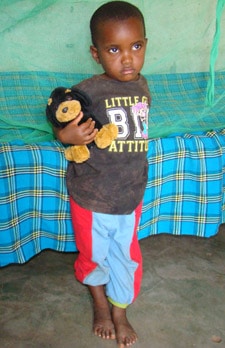
This is the home of Amina, a toddler enrolled in the local Child Survival Program (CSP). At the back of the homestead lies waste from the nearby kitchen. On the other side of the home are thick bushes of indigenous trees.
As the CSP specialist visited the mother, mosquito bites could be noted on the face of the child. Throughout the session, the TEEEE! TEEEE! sound of mosquitoes could be heard.
In some countries, mosquitoes are just nuisance, but in Riaciina, mosquitoes pose a deadly threat. Mosquito-borne malaria is the major killer disease in the area.
Riaciina village lies in the semi-arid part of Kenya on the extreme southern slopes of the largest mountain in Kenya, Mount Kirinyaga. The occupants are mainly the Ambeere and the Akaamba people whose primary work is farming and fishing.
On the lower side of the community lies the River Tana, the longest river in Kenya. The areas surrounding the river are dumpy and bushy — a breeding ground for mosquitoes. The infestation of the parasites is especially heavy along the riverbanks during rainy season.
Community members cannot escape the mosquitoes, as this is their only water source. Poor sanitation and disposal of kitchen wastes has also increased the mosquito breeding areas. The area has high maternal and infant mortality rates due to malaria-related complications.
According to a report from a nearby dispensary, an estimated 11 percent of mothers die before childbirth, while about 20 percent of children die before 5 years of age due to severe malaria. Lack of adequate food due to poverty, especially during the dry season, and malnutrition have led to low immunity. A survey by the local health officials shows that there has been an increase in the number of malaria cases and deaths reported in the previous year.
The living standard of the community members is low. Many children rarely attend school and the majority of adults are illiterate. Over 70 percent of the entire adult population is jobless. Those who find casual jobs bring home an average of $1.25 per day. This amount of money cannot provide for a large family’s daily meal.
An average mosquito net, which can greatly reduce cases of malaria, costs $3.25. The caregivers cannot afford to buy mosquito nets for all their children.
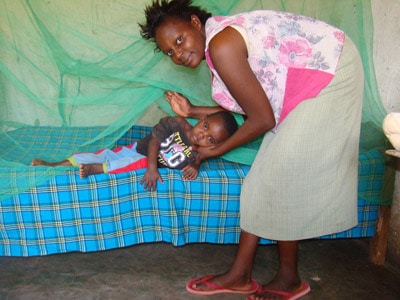
AIDS is also on the rise in the community. The pandemic has left many children either homeless or under the care of their aged grandparents. These children are exposed to malaria infection since the poor caregivers either cannot afford or have no knowledge of the importance of using insecticide treated mosquito nets (ITNS). Due to their illiteracy, the caregivers have no basic knowledge on malaria preventive measures either.
More than 50 percent of the malaria-associated deaths in the region are the result of less effective antimalarial drugs, poor management and improper diagnosis, and lack of knowledge by the primary caregivers on the importance of early disease interventions.
Some villagers use indigenous plants to create herbal remedies for the treatment of malaria. The herbs and leaves are boiled to form a colored liquor. They have no knowledge on actual dosages; therefore, most of those using the drug are referred to main hospitals with complicated severe malaria. Those who cannot afford transport to main hospitals die as a result.
In 2008, little Amina was admitted to the hospital twice with severe malaria. As a Compassion-assisted child, she was able to receive much-needed treatment and her medical bills were covered by the program. Through malaria education, provision of mosquito nets and removal of the nearby bushes, the child is now healthy and free from malaria.
Tragically, Amina’s sister was not so fortunate.
In 2007, Amina’s elder sister Joyce was 3 years old when she contracted malaria. Joyce had been running a fever and was very weak. Her mother, Agnes, took her to a nearby dispensary. The child was unconscious; her body temperature was high and she had severe febrile convulsions.
According to Agnes, Joyce’s initial treatment was a traditionally prepared herbal remedy that lacked exact doses. Agnes collected herbs and administered them to her daughter without knowing that it would be the last time little Joyce would ever drink the herbal medicine.
According to the World Health Organization (WHO)’s guidelines for the integrated management of childhood illnesses, the child had severe malaria and therefore required urgent referral to a hospital. The family could not afford transport to the far distant hospital. The nearby Kenyan dispensary lacked facilities, so the helpless child died in the hands of her heartbroken mother.
This is one of the many stories in which children die of a disease that could otherwise have been prevented. Despite the tragic loss of her older daughter Joyce, Agnes is grateful that Amina is growing strong and no longer attacked by malaria.
The difference in Amina’s case was the presence of Compassion.
Our CSP staff members work tirelessly, in line with the local health officials, to ensure that the mosquito-breeding places are eradicated. Compassion strives towards this goal so that no other mothers suffer the loss of a child, as Agnes did.
The education by CSP staff on the importance of clearing the nearby bushes, use of treated mosquito nets (ITNS), use of insecticides and early interventions has made progress in reducing malaria in the region. In addition to families enrolled in the Child Survival Program, this information has also been passed to other community members.
During the CSP home-based trainings, the visiting neighbors are never left out. The use of compost pits as advocated by CSP has ensured proper disposal of kitchen waste, minimizing the number of mosquito breeding areas.
The CSP training on malaria is also extended to the pregnant mothers. Malaria is a deadly disease that has severe effects on the growing fetus. Mothers severely hit by the disease have low birth weight babies or even stillbirths as associated with plasmodia in the placenta.
Since malaria has become resistant to most of the common drugs, the government has introduced other strong antimalarial drugs. The drugs are quite efficient in the control of the disease, but are rarely affordable. The use of a sulfur drug (fansidar) during pregnancy has reduced the number of malaria cases among the CSP pregnant mothers.
Our Child Survival Program has changed the lifestyles of many families in Riaciina. A survey by the CSP staff at the end of 2009 showed that:
- More than 90 percent of the community members had compost pits where kitchen wastes are deposited and burned.
- The training on modern methods of farming has led to proper utilization of the available land; most of the bushes where mosquitoes once thrived are now cleared.
- The malaria morbidity and mortality rate among children under 5 years old is now going down progressively.
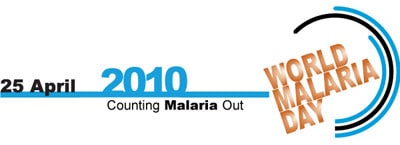
Malaria has plagued humankind since ancient times and is still a significant threat to half of the world’s population; 3.3 billion people living in 109 countries are at risk of contracting the disease. Estimates suggest that malaria afflicts between 350 and 500 million people every year. In addition, as many as 30,000 visitors to tropical countries are infected annually.
April 25 is a day of unified commemoration of the global effort to provide effective control of malaria around the world. This year’s World Malaria Day marks a critical moment in time. The international malaria community has less than a year to meet the 2010 targets of delivering effective and affordable protection and treatment to all people at risk of malaria, as called for by the UN Secretary-General, Ban Ki-Moon.
(Excerpt from rollbackmalaria.org)

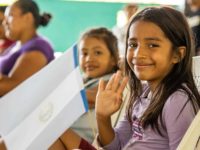
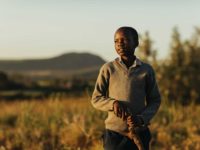

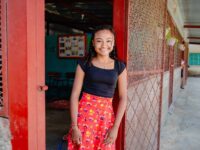


4 Comments |Add a comment
Hi, what happens if the sibling of the sponsored child gets sick? Does Compassion help them too?
Hi Estera! Thank you for your question and concern for the children’s families. The wonderful student center staff are trained in how to care for the needs of the children in our program, and their local budget allows them to respond immediately. The siblings and families of registered children do benefit from the program indirectly. The level at which medical care can be extended to a child’s sibling varies and is dependent on the capacity and capabilities of each individual center. If a sponsor learns that their child’s sibling is sick, the sponsor is always welcome to send a family gift to help if they choose. Please know that child and family gifts are never expected but always a blessing. Please email us at [email protected] if you have further questions. Have a blessed day!
thank you for sharing this Elizabeth! I have 2 kids in Kenya-Kima and Olepolous and this is probably a major problem in those to locations too. My kids have never mentioned this in letters but, hopefully when I send a family gift, nets were bought if needed. Please keep writing these blogs-you write beautifully.
I have a co-worker who is from Tanzania and the last time he went home for a visit, he was bitten by a mosquito while he was out at night. He contracted Malaria but since he was in the city and had access to good healthcare, all he had to do was take 2 pills and the Malaria was gone.
Children living in poverty in rural areas do not have the same access so the Insecticide Treated Nets are so very important!